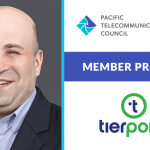
Gary Smith, Ciena’s President & CEO, shared his perspective on surviving a disrupted marketplace with Stephen McClelland.
For Gary Smith, a best of breed strategy overcame a disrupted marketplace
Gary Smith has more reason than most CEOs in the ICT industry to mull the finer points of corporate survival strategy in a high-tech environment. As a senior executive at Ciena, he weathered the dotcom bust at the turn of the millennium, and was soon after named CEO at a time when the company’s business had slumped dramatically.
For Ciena, it had been a spectacular rise and fall. In the leadup to the crash, the company had ridden the optical networking wave to huge market success. In the boom, it was feted by the industry and investment community alike as a key supplier of DWDM technologies to telcos globally. Success propelled a massively successful IPO, the premier one of its time. However, the ensuing bust put a ferocious squeeze on the company as network investment dried up.
Surviving – and thriving – meant new rules in a different marketplace for the new CEO. Today, other parts of the industry may need to adopt a similar rethink.
Rule No 1: Go best of breed
Gary Smith – unlike many of his counterparts across the industry – decided that the first rule of improving fortunes needed Ciena to adopt a best-of-breed strategy as the supplier specialist in “moving bits optically.” Stabilizing the company meant a continued focus on particular marketplaces, as well as judicious acquisitions and partnerships.
In telecom terms, this flew in the face of the then conventional wisdom. But around the industry, major vendors were already being pressurized to do things differently. Essentially, many would need to make a journey from being generalists overseeing complete, often proprietary, network platforms with end to end functionality themselves to specialist providers offering superior and more tailored solutions. For some major vendors with significant worldwide overhead and legacy to support, the misinterpretation of a radically changed market was to prove little short of fatal. “We challenged this notion [of supplying full service end to end networks],” he points out, along with other players such as Juniper Networks.
Gary Smith — an industry veteran with stints at Intelsat and Cray Communications as well as Ciena under his belt — admits that the best of breed approach was contrarian at the time but born from necessity. Perseverance came in useful, too. “Tenacity [of purpose] is an underrated strategy,” he wryly admits.
Rule No 2: Scale controllably and leverage competencies
Being global is “still a pivotal requirement” in the new era, he argues, but it comes as part of a move to leverage core competencies. This leveraging takes several forms. One is the drive to make Ciena’s USD 500 million annual spend on research and development matter for best of breed technology. As he notes, it’s also a significant market barrier for other competitors.
As part of the leverage strategy, acquisitions in targeted areas have also been important, as a string of purchases of varying size since the downturn signifies. Some propelled the company to its next stage, most notably the acquisition of Nortel’s Metro Ethernet Networks business in 2010. This proved a key move that effectively more than doubled Ciena’s size at the time and gave new market and technology access to the Ciena portfolio.
The resulting leverage through acquisitions and organic growth has meant a much-expanded customer base globally. In turn, Ciena’s own industry position was consolidated; it achieved first place in related markets from data center connectivity and submarine telecom connectivity upgrades. There seems little let up in optical networking progress with the company announcing this fall the industry’s first single carrier 400G solution.
Rule No 3: Think about people more than technology
Navigating a fast-moving market needing high technology skillsets has meant a renewed reflection on people management and team-building, he emphasizes. “It may seem strange in a technology-led company but even technology businesses are ultimately about people because technology issues can always be revisited,” he concludes. He points out the importance of this in making acquisitions a success. “The Nortel acquisition brought a global scope and an extended product range to Ciena,” he reflects. “But it also brought access to high quality people keen to join a company aiming for global presence in this area.”
Rule No 4: Be agile and responsive through network openness – you can reclaim territory
In leveraging competencies, Mr. Smith has also steered Ciena from a proprietary technology approach in the industry that frequently offered service providers little flexibility into increasingly open environments where service providers could use programmable functionalities.
It’s perhaps ironic that the changes vendors have seen are now arriving at the door of the service provider community – and might well need similar ways of thinking.
He says the industry worldwide is in a high-growth phase, but has been asking itself: who is extracting most value from the new environment? Established service providers including telcos must now contend with bold new entrants in greenfield deployments from the content and OTT space in a much more complicated value chain.
He contends these developments – in a multi-billion dollar industry transformation that forms a key theme for PTC attendees from across the industry – are yet to fully play out. “Service providers could reclaim the space they have so far ceded to content players because they connect to the end customer… That is not going to go away,” he argues. “In fact, we are seeing the need to get [content delivery] closer to customers with increasingly sophisticated caching and other techniques.”
However, many service providers are restricted by legacy OSS/BSS systems that are expensive, fragmented or inflexible, he observes, whereas the evolving need is for market responses that are much more tailored and agile and better suited to a fundamentally on-demand marketplace.
The outlook, he suggests, therefore, must be for much increased levels of “intelligent automation” in network operations offering radically increased flexibility and agility. Emerging areas such as advanced network analytics that not only enable cost-efficient operations but predict network health, along with a comprehensive evolution in software-defined networks and network functions virtualization (SDN/NFV) will be critical here, he reflects. SDN/NFV solutions are currently in carrier trials but should offer customers, he says, much better service integration and assurance as well as expediting service delivery. Meeting unprecedented user demand particularly in video delivery is also critical. NFV solutions from Ciena and partners are being trialled by Orange in the industry’s first vCDN architectures to deliver ultra-high quality live and streamed video to users.
As video demand shows, there is certainly enough potential market opportunity for players, he argues. The marketplace may have been radically disrupted but he suggests that “outside of the dotcom bust itself the fundamental optical networking space has not suffered undue cyclical upheaval.” Growth, he predicts, will continue as new demand makes its presence felt. “IoT, self-driving cars, 5G, and emerging markets will all play a part in the next phase of industry development,” he says.
Gary Smith will be one of our featured presenters at PTC’18 during the Tuesday Morning Keynotes on 23 January 2018.




